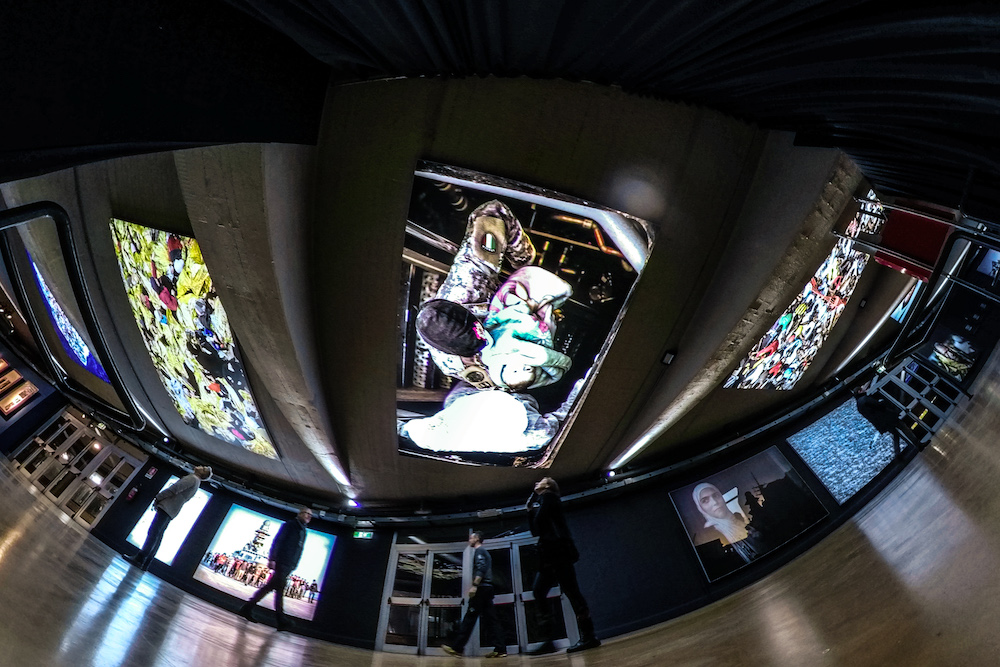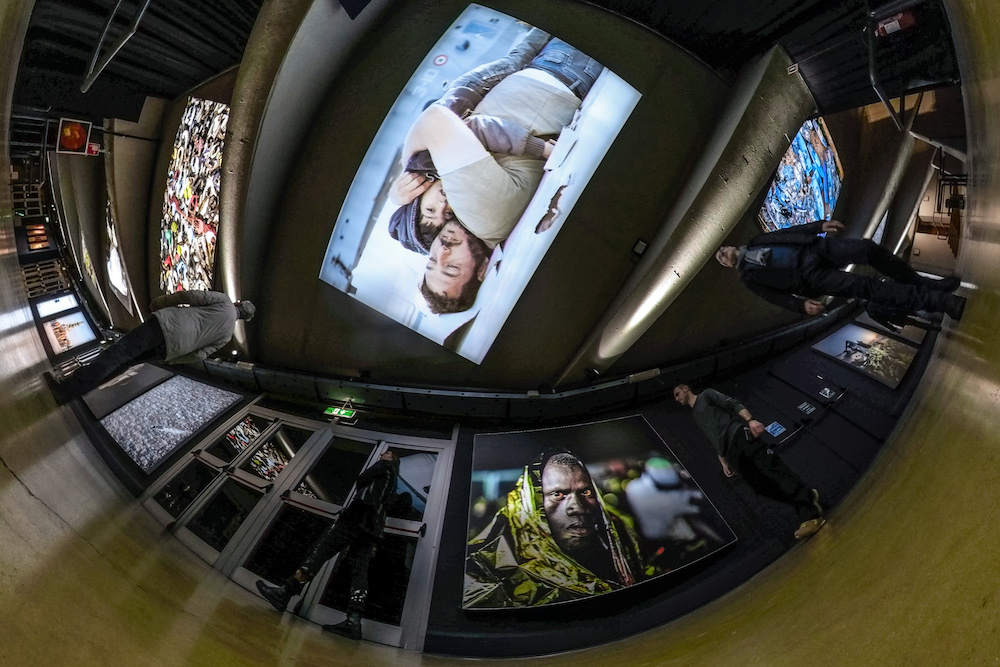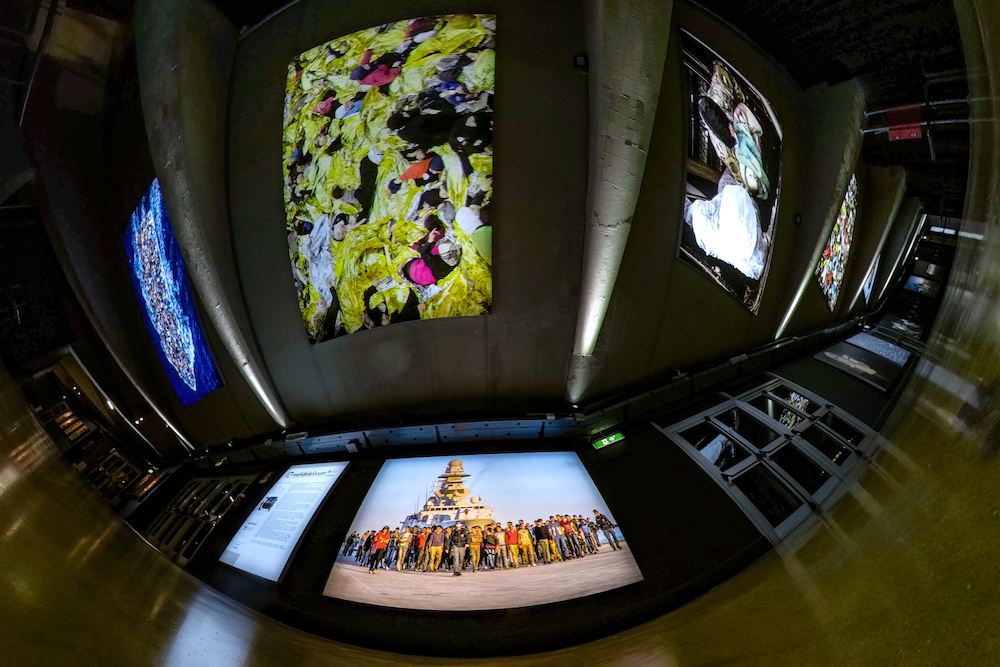by Enrico Stefanelli
_
The exhibition Mediterraneum – The right to hope, shots from the sea, opened on 12 February at the Mandela Forum in Florence. The exhibition gathers 14 of the photographs taken by Massimo Sestini during the days spent on board the Bergamini Frigate as a witness to the Navy’s rescue operations in aid of the refugees.

The permanent installation, with large-format and back-lit images, closes the year of celebrations dedicated to the centenary of the birth of Nelson Mandela. The intent is to show the difficult path to reach what are universal rights, ratified by the Universal Declaration of Human Rights, and also to renew the commitment that the governments of the world took in 1979 by signing the International Convention on Maritime Research and Rescue. A document which states: “The parties guarantee that assistance is provided to any person in difficulty at sea. They will do it regardless the nationality or status of that person or the circumstances in which that person was found. ”
We took this opportunity to have an interesting chat with Massimo Sestini.
About the winning photograph of the World Press Photo in 2015; do you want to tell us more about the situation in which you took it?
I was allowed to stay on the Fregata Bergamini for 5 days and, after those 5 days, I went to the Commander and told him: “I’m not leaving.” Then they called Rome and got the special authorizations that allowed me to stay on board for 15 days. On the thirteenth day, the waves calmed down and after 5 hours we finally received the phone call that allowed the rescue of the boat. It was the photo of that boat that won me the World Press Photo.

The 14 photographs on exhibition were taken on those 15 days aboard the Bergamini Frigate, would you like to tell us more about some of the shots?
This is a photograph of a Syrian; it is possibly one of my favorites because the father’s gaze and his son’s speak to each of us more than any word. The child’s eyes follow us. The bloody red eyes of this man..a man who spent a night in the open under the isothermal blanket to limit his suffering: a look that is so disturbing, so deep that penetrates the viewer. This is the cemetery of abandoned barges in Lampedusa. Always in an orthogonal plan, every photograph I took from above was taken very precisely. Always. This jumble reminds us of our car graveyards. But here we are talking about rust buckets that have carried, and in some cases lost at sea, hundreds and hundreds of people. It gives us an idea of the enormous number of people that the Frigate Bergamini may have transported, carrying out a rescue after the other. Thousands of people … Imagine the work of those on board: identifying, treating, quenching the thirst of all those people saved from the sea. An apocalypse.

Any particular anecdote above all?
A few days ago, I met one of the barge boys, after five years since our first encounter. I hadn’t met him in person, he was one of the 500 people who stood hundreds of feet below me that day. It was him, instead, who told me: “I will always remember the moment when I saw your helicopter and you dangling down and taking our pictures. You were the sign of something that came to save our lives ”.
How can you stay rational in the face of certain situations when you have to take these photographs?
You need nerves of steel and to keep it that way. Because you learn that, in order to take photos, certain factors must be controlled. It is something not too different from the lucidity of a rescuer performing CPR on you. You have to remain lucid, there are people around you who are doing everything possible to save others and you are in charge of documenting and telling what is happening, in the most objective way possible.
How did this experience change you?
We have become cynical: all wars end up looking the same and so do all earthquakes, you get used to everything. But on this ship and the others on which I have been in these two years, I began to feel emotions that I had not felt before; I had faces in front of me looking at me and communicating something to me. I learnt to be multi-tasking, to be sensitive while remaining able to do what I had to do, to document the facts in order to convey the emotions in the images, reaching the mind and heart of people through the photos, which is the deepest mean of communication there is. The excitement I feel now with this exhibition is also crazy. I begin to understand that at the age of 56, I can still experience excitement and emotions
This permanent exhibition at the Nelson Mandela Forum closes the year of celebrations dedicated to Nelson Mandela. What does it mean for you personally, Massimo?
For my journey as a photojournalist and paparazzo (I am so proud to have started as a paparazzo because that taught me lessons that I used in reportage and portraiture) it was inconceivable to put a photograph on display in a public place, without profit. Usually a photographer has an exhibition to launch a book of his, to sell his photographs.
This initiative was born from an idea of Massimo Gramigni, who last year told me: “Let’s do this thing, I’ll put a fee for you in the budget, just tell me how much”. I immediately replied: “Nothing”, I thought about it for a mere second. I’m telling you the truth, the excitement of doing something that could support, in some way, the cause of thousands of people, from different countries and different ethnic groups, gave me a bit of adrenaline. It was something I had never done. And then, you know, I feel temporary and precarious: I can die any moment, especially with my work. And to think that someone, in the future when I am gone, will look at my images and experience some kind of emotion, and not through a photo sold to a newspaper for a profit, it’s great stuff. So I did my best. I found a team of fantastic people who made such great prints. What we wanted to do with Gramigni was to leave a type of emotion that could be social and not just personal. An emotion that could make each of us feel able to change those things that do not seem right to us.

Your next project?
I’m trying to track down the people who were on that boat. For now we have found about 50 people, NG Channel has helped us a lot. We are making a 44-minute video that will be broadcast in over 170 countries around the world and will be presented next June 20th on the occasion of World Refugee Day. My goal is to tell the stories of these people through a dozen portraits, reaching them where they are living and entering into their daily lives. I want the portraits to be taken from the same zenith perspective with which I had photographed the boat, so they’ll have a common thread.
March 28, 2019




